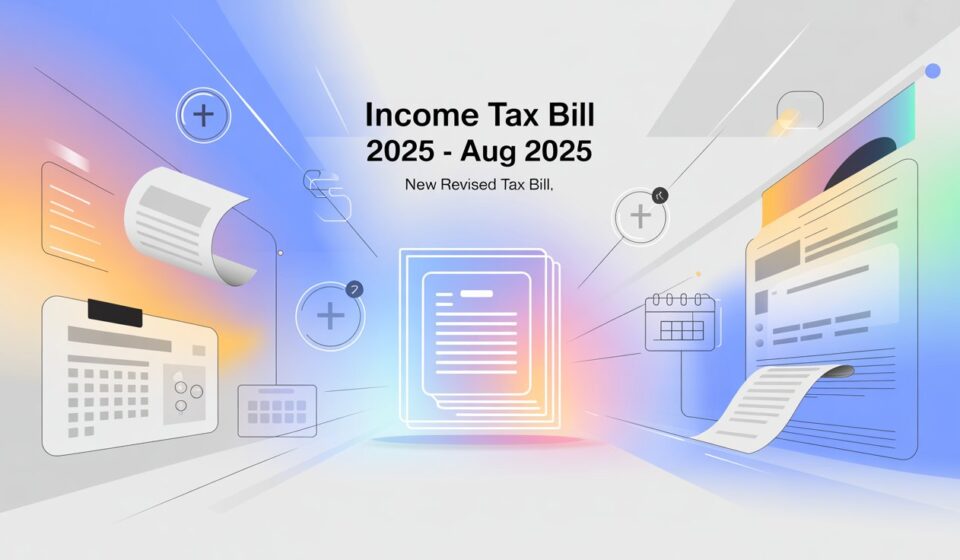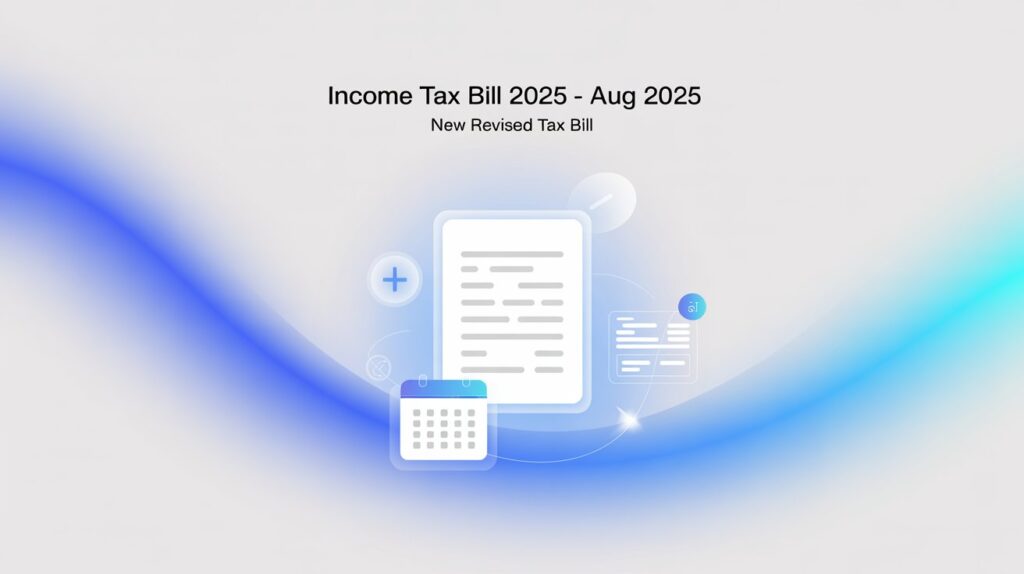
Income Tax Bill 2025 (Revised Aug 11, 2025) – Key Changes and Impacts
A comprehensive guide to India’s new Income Tax Bill 2025 (revised on Aug 11, 2025). Learn its major reforms – such as the new tax year concept – and how they affect individuals, businesses, NRIs and trusts. Includes official references and compliance tips.
Table Of Content
- Overview
- Important Highlights of the Revised Bill
- Major Provisions & Definitions
- Impact on Stakeholders
- Compliance & Next Steps
- Frequently Asked Questions
- When will the new Income Tax Bill take effect?
- Does the Bill change tax rates or slab structure?
- What exactly is the new “Tax Year”?
- How are NRIs affected by the new Bill?
- Where can I read more about the new Bill?
Overview
The Income Tax Bill, 2025 is a complete rewrite of India’s six-decade-old tax law. It was re-tabled in Parliament on 11 August 2025 after earlier drafts were revised. Rather than altering tax rates, the Bill reorganizes and simplifies the law. For example, redundant sections and provisos are being cut down (from over 800 sections to 536), and all provisos/explanations (~2,100 in total) are removed. The Bill’s language is made clear and straightforward – in the Finance Minister’s words, the goal is a law that is “concise, lucid, easy to read and understand”. Crucially, it replaces the confusing “previous year/assessment year” framework with a single Tax Year (the 12-month period from April 1). (Taxpayers can now simply use “Tax Year 2024–25” instead of AY 2025–26.)
Timeline: Key events for the Bill were:
- 13 Feb 2025: Original Income-tax Bill introduced in Lok Sabha (sent to Select Committee).
- 21 Jul 2025: Parliamentary committee reports back with suggestions.
- 8 Aug 2025: Original Bill withdrawn for revisions.
- 11 Aug 2025: Revised Income-tax (No.2) Bill, 2025 tabled and passed by Lok Sabha.

Important Highlights of the Revised Bill
- Tax Year replaces Assessment Year: The Bill defines Tax Year as the 12-month financial year (e.g. Apr 1–Mar 31), eliminating the old “previous year/assessment year” confusion. Now all income earned in a financial year is taxed in that same “Tax Year,” simplifying filings.
- No change in rates or slabs: The Bill deliberately does not alter tax rates or slabs. Existing basic exemption limits and brackets remain applicable, ensuring continuity for taxpayers.
- Massive simplification: By halving the Act’s length, the new law collapses overlapping sections and removes outdated wording. For instance, items like multiple provisos and legacy cross-references are replaced by clear tables and subsections. The structure is reorganized into 23 chapters (down from 47) and 536 sections.
- Unified deductions: Many deductions (e.g. Sections 80C–80U) are grouped under one heading “Deductions in computing total income,” so taxpayers can see all benefits in one place. Notably, standard deduction on house property is explicitly allowed on the post-municipal-tax rent. Also, pre-construction home loan interest can now be spread over five years even for rental properties. These clarifications remove past ambiguities.
- Digital & faceless compliance: The Bill codifies the faceless tax regime. Assessment, appeals and notices will largely happen online with clear timelines. It also streamlines TDS/TCS rules. For example, taxpayers can apply for a “nil” deduction certificate before the year starts, and small refunds can be granted even after the return deadline without penalties.
- Residence rule for NRIs: The income‑threshold test is formalized. Now, an Indian citizen/PIO who stays ≥120 days (instead of 60) will be deemed resident if his India income exceeds ₹15 lakh. In contrast, NRIs earning under ₹15 lakh in India remain exempt from this 60-day rule. (Put simply, high-earning NRIs face a tougher test for non‑residency.)
- Trusts and charities: Restrictions on anonymous donations are relaxed for religious trusts. The Bill restores tax exemption for “secret” donations to purely religious institutions (it still disallows it for charities that run social services). This tweak rewards genuine charity while maintaining transparency.
- Other tweaks: Inter-corporate dividend deductions (Section 80M) were reinstated, standard pension commutation deductions remained, and corporate loss carry-forwards were liberalized for ‘beneficial owners’ (as per committee suggestions).
Major Provisions & Definitions
- Tax Year (Clause 3): The Bill’s Section 3(1) defines Tax Year as the twelve-month period beginning April 1. All calculations of income, deductions and filings will use this term. The old terms “assessment year” and “previous year” are entirely removed.
- Residential status (Section 6): Rules to determine if a person is resident of India are largely unchanged (182-day rule and 60-day rule) but include new criteria. Critically, Section 6(5) states that if an Indian citizen/PIO earns over ₹15 lakh (excluding foreign income), then the 60-day rule is replaced by a 120-day test. All other residency rules mirror the 1961 Act (e.g. 182-day/365-day requirements).
- Virtual digital assets/spaces: The Bill explicitly defines digital terms. It defines “virtual digital asset” (broadly, cryptocurrencies, NFTs, etc.) as any token or code representing digital value. It also defines “virtual digital space” to include any computer-based realm – such as email servers, social media, online bank/trading accounts, websites and cloud servers. This means tax authorities can legally access data in these electronic environments during searches, closing previous legal gaps.
- Faceless assessment: While the faceless scheme (introduced in 2019) will continue, the new law codifies its procedures. Clear timelines and email-based communication are mandated for assessments, reducing discretion and human interface.
- TDS/TCS provisions: The Bill creates explicit powers for issuing advance ‘nil’ deduction certificates and allows certain TDS/TCS refunds to be granted outside normal deadlines (especially for small amounts), as suggested by the Select Committee. Penalty waiver provisions for unintentional defaults are also incorporated to make the regime taxpayer-friendly.
- House property rules (Clause 22): It spells out that rental income is computed after a 30% standard deduction post property tax. For example, if you pay municipal taxes on a rented property, 30% of the remaining rent is deductible by law. It also explicitly allows phased interest deduction for home loans on let-out properties (spread over 5 years). These write-ins remove past uncertainties in Sections 23 and 24 of the old Act.
Impact on Stakeholders
- Individuals and Salaried Employees: Taxpayers will see most benefits through easier filing and clarity. All deductions (life insurance, medical insurance, donations, etc.) are now listed in one place, so you no longer flip between Sections 80C–80U. The standard deduction on rent (30%) after tax is clear. Faceless processing means fewer visits to tax offices – all notices arrive by email. Importantly, if you missed filing your ITR by the deadline, you may still claim refunds of small TDS amounts without late penalties. Tax slabs and rates you faced under the old law remain the same, so your basic tax liability won’t suddenly change.
- Businesses and Startups: Companies will appreciate the removal of archaic provisions. The updated definition of “beneficial owner” (as per recommendations) lets firms carry forward and set off past losses even after changes in shareholding. The Bill brings back Section 80M, allowing deduction of certain inter-corporate dividends. Depreciation and other allowances remain largely unchanged but are written in clearer format. Firms should also note any amended definitions (e.g. of “parent company” or “controlled group”) when restructuring. Overall, compliance will be smoother due to simpler language and reduced litigation.
- Non-Resident Indians (NRIs): The key change is in residency rules. An NRI who earns over ₹15 lakh (excluding foreign income) and stays 120 days in India (and 365 days over 4 years) will now be taxed as resident. In contrast, high-earning Indians working abroad or as ship crew remain exempt from the 60-day rule. Practically, high-income NRIs must monitor their Indian income and days in India more carefully. Also, as now residency is decided by the tax year, those nearing the ₹15 lakh threshold should plan travel and income timing.
- Trusts and NGOs: Purely religious trusts regain the benefit of anonymous donations (the Bill explicitly exempts these from tax). However, charitable trusts running schools or hospitals do not get this exemption if they collect undeclared donations. In practice, nonprofit managers should document the nature of donations carefully. The standard rules (80G, etc.) otherwise persist, but the law’s intent is to treat religious and secular charities differently here.
- Investors and Others: Tax rules on capital gains, securities and dividends largely stay the same, but with improved clarity. Importantly, exemptions under securities laws (e.g. 10(38) for stock gains) and the flat 10% LTCG on equities remain untouched. Now that cryptos are defined as virtual digital assets, any gains from crypto or NFT trading clearly fall under “income” and will be taxed accordingly. Investors should also note the codified power to treat online accounts (wallets, exchange accounts, etc.) as searchable – this adds transparency. Overall, since no new surcharges or taxes were introduced, asset-buying rules remain as before, just under simpler law language.
Compliance & Next Steps
The revised Bill has passed the Lok Sabha and must now be approved by the Rajya Sabha and receive Presidential assent. Upon enactment, it will supersede the old Act for tax years beginning on or after April 1, 2026 (i.e. FY 2026–27 and AY 2026–27 onward). (All proceedings for tax years before 2026 will continue under the 1961 Act.) Taxpayers should therefore continue filing under the old law for FY 2025–26, and shift to the new rules for FY 2026–27. In the interim, officials will likely issue updated ITR forms, schedules and FAQs.
Action items: Individuals and businesses should monitor announcements by the Income Tax Department (see the official portal and FAQs). Begin thinking in terms of “Tax Year” in your ledgers and ITR filings. Update payroll, accounting and legal systems (and payroll software) to use the new definitions. NRIs should recalculate their days-and-income to check residency status under Sec.6(5). Property owners can adjust to the clarified deduction rules, and trusts/charities should review donation clauses. Because the new law is simpler, it can reduce mistakes – but it also means there’s less wiggle room, so follow its clear wording.

Frequently Asked Questions
When will the new Income Tax Bill take effect?
Once enacted, the Bill applies to tax years beginning on/after April 1, 2026 (i.e. FY 2026–27 onwards). All assessments for years before that (including FY 2025–26/AY 2026–27) will proceed under the old 1961 Act.
Does the Bill change tax rates or slab structure?
No. The Finance Minister and official documents emphasize that existing tax slabs and exemptions (e.g. basic exemption) remain the same. Only the text and procedures change.
What exactly is the new “Tax Year”?
Section 3(1) of the Bill defines tax year as the financial year April 1 to March 31. In practice, this means income earned in FY 2026–27 will be reported as “Tax Year 2026–27” (no separate AY term). The concepts of “previous year” and “assessment year” are abolished.
How are NRIs affected by the new Bill?
The primary change is Sec. 6(5). A visiting Indian citizen or PIO with India income above ₹15 lakh will now be deemed resident if they stay 120 days (up from 60) and have 365+ days over 4 years. By contrast, Indians working abroad or PIOs with income under ₹15 lakh continue to be exempt from short-stay rules. In short, wealthy NRIs need to track days and income carefully.
Where can I read more about the new Bill?
Official materials (Bills text, press releases, FAQs) are on the Income Tax Department website under Income-tax Bill, 2025. The Parliamentary debates and explanatory press releases provide context. Reputed media (e.g. Financial Express, Economic Times, Times of India) have published summaries and analyses of the Bill’s contents.



